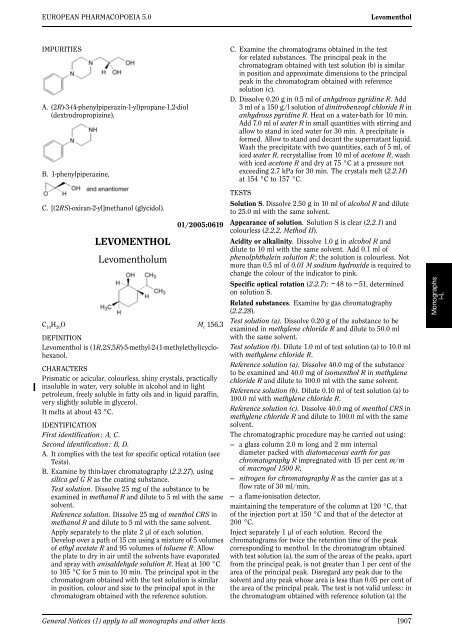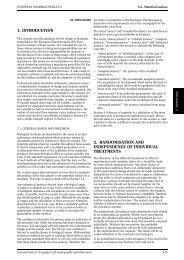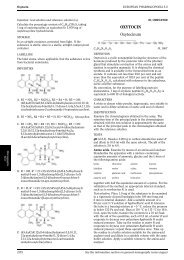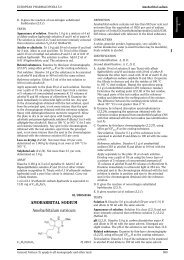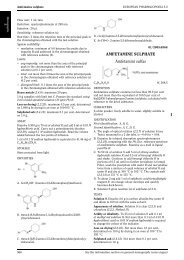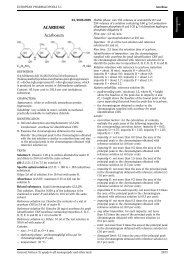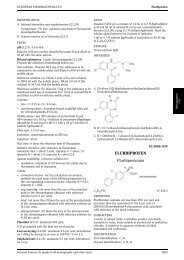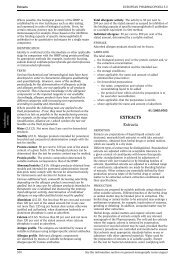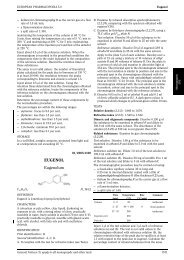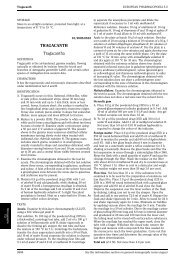LEVOMENTHOL Levomentholum
LEVOMENTHOL Levomentholum
LEVOMENTHOL Levomentholum
Create successful ePaper yourself
Turn your PDF publications into a flip-book with our unique Google optimized e-Paper software.
EUROPEAN PHARMACOPOEIA 5.0 Levomenthol<br />
IMPURITIES<br />
A. (2R)-3-(4-phenylpiperazin-1-yl)propane-1,2-diol<br />
(dextrodropropizine),<br />
B. 1-phenylpiperazine,<br />
C. [(2RS)-oxiran-2-yl]methanol (glycidol).<br />
<strong>LEVOMENTHOL</strong><br />
<strong>Levomentholum</strong><br />
01/2005:0619<br />
C10H20O Mr 156.3<br />
DEFINITION<br />
Levomenthol is (1R,2S,5R)-5-methyl-2-(1-methylethyl)cyclohexanol.<br />
CHARACTERS<br />
Prismatic or acicular, colourless, shiny crystals, practically<br />
insoluble in water, very soluble in alcohol and in light<br />
petroleum, freely soluble in fatty oils and in liquid paraffin,<br />
very slightly soluble in glycerol.<br />
It melts at about 43 °C.<br />
IDENTIFICATION<br />
First identification: A, C.<br />
Second identification: B, D.<br />
A. It complies with the test for specific optical rotation (see<br />
Tests).<br />
B. Examine by thin-layer chromatography (2.2.27), using<br />
silica gel G R as the coating substance.<br />
Test solution. Dissolve 25 mg of the substance to be<br />
examined in methanol R and dilute to 5 ml with the same<br />
solvent.<br />
Reference solution. Dissolve 25 mg of menthol CRS in<br />
methanol R and dilute to 5 ml with the same solvent.<br />
Apply separately to the plate 2 µl of each solution.<br />
Develop over a path of 15 cm using a mixture of 5 volumes<br />
of ethyl acetate R and 95 volumes of toluene R. Allow<br />
the plate to dry in air until the solvents have evaporated<br />
and spray with anisaldehyde solution R. Heatat100°C<br />
to 105 °C for 5 min to 10 min. The principal spot in the<br />
chromatogram obtained with the test solution is similar<br />
in position, colour and size to the principal spot in the<br />
chromatogram obtained with the reference solution.<br />
C. Examine the chromatograms obtained in the test<br />
for related substances. The principal peak in the<br />
chromatogram obtained with test solution (b) is similar<br />
in position and approximate dimensions to the principal<br />
peak in the chromatogram obtained with reference<br />
solution (c).<br />
D. Dissolve 0.20 g in 0.5 ml of anhydrous pyridine R. Add<br />
3 ml of a 150 g/l solution of dinitrobenzoyl chloride R in<br />
anhydrous pyridine R. Heatonawater-bathfor10min.<br />
Add 7.0 ml of water R in small quantities with stirring and<br />
allow to stand in iced water for 30 min. A precipitate is<br />
formed. Allow to stand and decant the supernatant liquid.<br />
Wash the precipitate with two quantities, each of 5 ml, of<br />
iced water R, recrystallise from 10 ml of acetone R, wash<br />
with iced acetone R and dry at 75 °C at a pressure not<br />
exceeding 2.7 kPa for 30 min. The crystals melt (2.2.14)<br />
at 154 °C to 157 °C.<br />
TESTS<br />
Solution S. Dissolve 2.50 g in 10 ml of alcohol R and dilute<br />
to 25.0 ml with the same solvent.<br />
Appearance of solution. Solution S is clear (2.2.1) and<br />
colourless (2.2.2, Method II).<br />
Acidity or alkalinity. Dissolve1.0ginalcohol R and<br />
dilute to 10 ml with the same solvent. Add 0.1 ml of<br />
phenolphthaleinsolutionR; the solution is colourless. Not<br />
more than 0.5 ml of 0.01 M sodium hydroxide is required to<br />
change the colour of the indicator to pink.<br />
Specific optical rotation (2.2.7): −48 to −51, determined<br />
on solution S.<br />
Related substances. Examine by gas chromatography<br />
(2.2.28).<br />
Test solution (a). Dissolve 0.20 g of the substance to be<br />
examined in methylenechlorideRand dilute to 50.0 ml<br />
with the same solvent.<br />
Test solution (b). Dilute 1.0 ml of test solution (a) to 10.0 ml<br />
with methylene chloride R.<br />
Reference solution (a). Dissolve 40.0 mg of the substance<br />
to be examined and 40.0 mg of isomenthol R in methylene<br />
chloride R anddiluteto100.0mlwiththesamesolvent.<br />
Reference solution (b). Dilute 0.10 ml of test solution (a) to<br />
100.0 ml with methylenechlorideR.<br />
Reference solution (c). Dissolve 40.0 mg of menthol CRS in<br />
methylene chloride R and dilute to 100.0 ml with the same<br />
solvent.<br />
The chromatographic procedure may be carried out using:<br />
— a glass column 2.0 m long and 2 mm internal<br />
diameter packed with diatomaceous earth for gas<br />
chromatography R impregnated with 15 per cent m/m<br />
of macrogol 1500 R,<br />
— nitrogen for chromatography R as the carrier gas at a<br />
flow rate of 30 ml/min,<br />
— a flame-ionisation detector,<br />
maintaining the temperature of the column at 120 °C, that<br />
of the injection port at 150 °C and that of the detector at<br />
200 °C.<br />
Inject separately 1 µl of each solution. Record the<br />
chromatograms for twice the retention time of the peak<br />
corresponding to menthol. In the chromatogram obtained<br />
with test solution (a), the sum of the areas of the peaks, apart<br />
from the principal peak, is not greater than 1 per cent of the<br />
area of the principal peak. Disregard any peak due to the<br />
solvent and any peak whose area is less than 0.05 per cent of<br />
the area of the principal peak. The test is not valid unless: in<br />
the chromatogram obtained with reference solution (a) the<br />
GeneralNotices(1)applytoallmonographsandothertexts 1907
Levomepromazine hydrochloride EUROPEAN PHARMACOPOEIA 5.0<br />
resolution between the peaks corresponding to menthol and<br />
isomenthol is not less than 1.4 and the principal peak in the<br />
chromatogram obtained with reference solution (b) has a<br />
signal-to-noise ratio of not less than 5.<br />
Residue on evaporation. Evaporate 2.00 g on a water-bath<br />
andheatinanovenat100°Cto105°Cfor1h.Theresidue<br />
weighs not more than 1.0 mg (0.05 per cent).<br />
LEVOMEPROMAZINE<br />
HYDROCHLORIDE<br />
01/2005:0505<br />
Levomepromazini hydrochloridum<br />
C19H25ClN2OS Mr 364.9<br />
DEFINITION<br />
Levomepromazine hydrochloride contains not less than<br />
98.5 per cent and not more than the equivalent of 101.0 per<br />
cent of (2R)-3-(2-methoxy-10H-phenothiazin-10-yl)-N,N,2trimethylpropan-1-amine<br />
hydrochloride, calculated with<br />
reference to the dried substance.<br />
CHARACTERS<br />
A white or very slightly yellow, crystalline powder, slightly<br />
hygroscopic, freely soluble in water and in alcohol. It<br />
deteriorates when exposed to air and light. It exists in two<br />
forms, one melting at about 142 °C and the other at about<br />
162 °C.<br />
IDENTIFICATION<br />
A. Prepare the solution protected from bright light and<br />
carry out the measurements immediately. Dissolve<br />
50.0 mg in water R and dilute to 500.0 ml with the same<br />
solvent. Dilute 10.0 ml of this solution to 100.0 ml with<br />
water R. Examined between 230 nm and 340 nm (2.2.25),<br />
the solution shows two absorption maxima, at 250 nm<br />
and 302 nm. The specific absorbance at the maximum at<br />
250 nm is 640 to 700.<br />
B. It complies with the identification test for phenothiazines<br />
by thin-layer chromatography (2.3.3).<br />
C. Introduce 0.2 g into a 100 ml separating funnel. Add<br />
5mlofwater R and 0.5 ml of strong sodium hydroxide<br />
solution R. Shake vigorously with two quantities, each<br />
of 10 ml, of ether R. Combine the ether layers, dry over<br />
anhydrous sodium sulphate R and evaporate to dryness.<br />
Keep the residue at 100 °C to 105 °C for 15 min and<br />
allow to crystallise in iced water. Initiate crystallisation if<br />
necessary by scratching the wall of the flask with a glass<br />
rod. Dry the crystals at 60 °C for 2 h. The crystals melt<br />
(2.2.14) at122°Cto128°C.<br />
D. It gives reaction (b) of chlorides (2.3.1).<br />
TESTS<br />
Solution S. Dissolve 2.50 g in carbon dioxide-free water R<br />
and dilute to 25.0 ml with the same solvent.<br />
Acidity or alkalinity. To 10 ml of solution S add 0.1 ml of<br />
bromocresol green solution R. Notmorethan0.5mlof<br />
0.01 M sodium hydroxide or 1.0 ml of 0.01 M hydrochloric<br />
acid is required to change the colour of the indicator.<br />
Specific optical rotation (2.2.7):+9.5to+11.5,determined<br />
on solution S and calculated with reference to the dried<br />
substance.<br />
Related substances. Carry out the test protected from bright<br />
light. Examinebythin-layerchromatography(2.2.27), using<br />
silica gel GF254 R as the coating substance.<br />
Test solution. Dissolve 0.2 g of the substance to be examined<br />
in a mixture of 5 volumes of diethylamine R and 95 volumes<br />
of methanol R and dilute to 10 ml with the same mixture of<br />
solvents. Prepare immediately before use.<br />
Reference solution. Dilute 0.5 ml of the test solution to<br />
100 ml with a mixture of 5 volumes of diethylamine R and<br />
95 volumes of methanol R.<br />
Apply separately to the plate 10 µl of each solution. Develop<br />
over a path of 15 cm using a mixture of 10 volumes of<br />
acetone R, 10volumesofdiethylamine R and 80 volumes of<br />
cyclohexane R. Allow the plate to dry in air and examine in<br />
ultraviolet light at 254 nm. Any spot in the chromatogram<br />
obtained with the test solution, apart from the principal<br />
spot, is not more intense than the spot in the chromatogram<br />
obtained with the reference solution (0.5 per cent).<br />
Loss on drying (2.2.32). Not more than 1.0 per cent,<br />
determinedon1.000gbydryinginanovenat100°Cto<br />
105°Cfor3h.<br />
Sulphated ash (2.4.14). Not more than 0.1 per cent,<br />
determined on 1.0 g.<br />
ASSAY<br />
Dissolve 0.300 g in 5 ml of water R and add 50 ml of<br />
2-propanol R. Titratewith0.1 M sodium hydroxide,<br />
determining the end-point potentiometrically (2.2.20).<br />
1mlof0.1 M sodium hydroxide is equivalent to 36.49 mg<br />
of C 19H 25ClN 2OS.<br />
STORAGE<br />
Store in an airtight container, protected from light.<br />
01/2005:0925<br />
LEVOMEPROMAZINE MALEATE<br />
Levomepromazini maleas<br />
C 23H 28N 2O 5S M r 444.6<br />
DEFINITION<br />
Levomepromazine maleate contains not less than 98.5 per<br />
cent and not more than the equivalent of 101.0 per<br />
cent of (2R)-3-(2-methoxy-10H-phenothiazin-10-yl)-N,N,2trimethylpropan-1-amine<br />
(Z)-butenedioate, calculated with<br />
reference to the dried substance.<br />
1908 See the information section on general monographs (cover pages)


